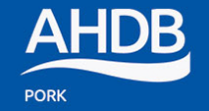WebHAT information sources
The early warning signs and risk factors explained in the Tail Biting WebHAT are those identified as the most important factors by an evidence-based Husbandry Advisory Tool (HAT), which was developed for an AHDB Pork project that ran from 2006 to 2009 (research funded jointly by AHDB Pork and by the RSPCA, and carried out by the University of Bristol with the University of Newcastle).
The original HAT was devised to help pig producers and their advisors identify and minimise possible risk factors for tail biting in finishing pigs8. The technical detail of the HAT was based on reviews of the literature9 and a workshop-led consultation with relevant experts (scientists, producers, veterinary surgeons, nutritionists and processors). A wide range of possible tail biting risk factors were identified, and then combined with further questions and observations of pig behaviour into a larger questionnaire. This was used to record the occurrence of tail biting risks on commercial pig farms from a range of producers in England (65 farms over a total of 176 visits, with over 28,000 pigs observed). From the statistically analysed results of this work, those risks most likely to influence tail biting were identified and quantified. These risks and are now presented within this Tail Biting WebHAT, where depending on the risk factors selected as being present on a farm, those most strongly associated with tail biting can be ranked in a printable report, along with specific advice and actions to reduce the occurrence of this problem behaviour.
Where more recent literature has identified important risks, or where a suggested risk could not be fully assessed during the HAT project, this has also been mentioned in the WebHAT pages, ie nutritional factors, genetic information, and previous history of the pigs (eg farrowing accommodation) which was rarely accessible during the HAT assessments.
While all stages of rearing pigs on the farm were included in the risk assessment, farm visits were specifically booked for when pigs of 80 kg or higher were due to be present (as this had been identified as a key risk stage), and the majority of units were grower/finisher or finisher only.
A key report since completion of the AHDB tail-biting project has been the EFSA Scientific Opinion concerning a Multifactorial approach on the use of animal and non-animal-based measures to assess the welfare of pigs10.This report looked specifically at the interactions between risk factors, welfare consequences and animal and non-animal-based measures on i) the absence of functional manipulable materials for pigs at different stages in life and ii) tail biting (for weaners and rearing pigs only). Findings of this major report verify the findings of the original AHDB project and HAT results, as well as extending the scope of investigation to a wider range of ages of pigs, and European pig rearing systems.
Details about where the information in the Tail Biting WebHAT has come from, references, links to literature, documents, websites and reports, etc. are provided below.
References
- Zonderland, J.J., van Riel, J., Bracke, M.B.M., Kemp, B., den Hartog, L.A., Spoolder, H.A.M. (2009) Tail posture predicts tail damage among weaned piglets. Applied Animal Behaviour Science, 121: 165-170.
- Simonsen, H.B., Klinken, L., Bindseil, E., (1991). Histopathology of intact and docked pig tails. British Veterinary Journal, 147: 407-412.
- Van de Weerd H.A., Docking, C.M., Day, J.E., Avery, P.J. and Edwards, S.A., (2003). A systematic approach towards developing environmental enrichment for pigs. Applied Animal Behaviour Science, 84, 101-118.
- Defra (2003). Codes of recommendations for livestock: pigs. Defra Publications, London.
- Van Putten, G., (1980). Objective observations on the behaviour of fattening pigs. Animal Regulatory Studies.
- Scott, K., Chennells, D.J., Armstrong, D., Taylor, L., Gill, B.P., and Edwards, S.A., (2007).The welfare of finishing pigs under different housing and feeding systems: liquid versus dry feeding in fully-slatted and straw-based housing. Animal Welfare, 16: pp. 53–62.
- Moinard, C., Mendl, M., Nicol, C.J. and Green, L.E., (2003). A case control study of on-farm risk factors for tail biting in pigs. Applied Animal Behaviour Science, 81: pp.333-355.
- Taylor, N.R., Parker, R.M.A., Mendl, M., Edwards, S.A. and Main, D.C.J. (2012) Prevalence of risk factors for tail biting on commercial farms and intervention strategies. The Veterinary Journal, 194: 77-83.
- Taylor, et al (2010) Tail-biting: A new perspective. The Veterinary Journal, 186: 137-147.
- EFSA (European Food Safety Authority) (2014). Scientific Opinion concerning a Multifactorial approach on the use of animal and non-animal-based measures to assess the welfare of pigs. EFSA Journal, 12: 3702 [101 pp.].
- Gadd, J. (2003). Pig Production Problems: A Guide to their Solutions. Nottingham University Press.
Useful links
Husbandry and welfare of pigs: https://ahdb.org.uk/knowledge-library/husbandry-and-welfare-of-pigs
Tail biting and tail docking in pigs: https://ahdb.org.uk/knowledge-library/tail-docking-and-tail-biting-in-pigs
AHDB work instruction – tail docking: https://projectblue.blob.core.windows.net/media/Default/Pork/Documents/Work%20instructions/WI%20-%20Tail%20docking.docx
Environmental enrichment for pigs: https://ahdb.org.uk/knowledge-library/environmental-enrichment-for-pigs
Information about ventilating pig buildings: https://ahdb.org.uk/knowledge-library/ventilating-pig-buildings
AHDB ventilating pig buildings guide http://pork.ahdb.org.uk/environment-buildings/pig-buildings-housing-development/ventilation/ventilating-pig-buildings-guide/
Strawing up and preventing draughts: https://ahdb.org.uk/knowledge-library/strawing-up-and-preventing-draughts
Daily checks regarding feed and water (video): https://youtu.be/boe3hR8e2Tk
Nutrition guidance for pigs: https://ahdb.org.uk/knowledge-library/nutrition-guidance-for-pigs
Mycotoxins in pig feed: https://ahdb.org.uk/knowledge-library/mycotoxins-in-pig-feed
Water guidance for pig farmers: https://ahdb.org.uk/knowledge-library/water-guidance-for-pig-farmers
Information about porcine reproductive and respiratory syndrome virus (PRRS): https://ahdb.org.uk/knowledge-library/porcine-reproductive-and-respiratory-syndrome
Information about ear tip necrosis: http://www.nadis.org.uk/bulletins/ear-tip-necrosis.aspx
Advice on mixing pigs by J. Gadd: http://www.thepigsite.com/articles/3793/mixing-pigs-without-tears/
Defra code of practice for the welfare of pigs: https://assets.publishing.service.gov.uk/government/uploads/system/uploads/attachment_data/file/908108/code-practice-welfare-pigs.pdf
Welfare Quality – “Appropriate behaviour” within the Pig Protocol: http://www.welfarequality.net/network/45848/7/0/40
EU Staff Working Document on best practices for the prevention of routine tail-docking and the provision of enrichment materials to pigs https://ec.europa.eu/food/sites/food/files/animals/docs/aw_practice_farm_pigs_stfwrkdoc_en.pdf
Environmental enrichment for confinement pigs: http://www.grandin.com/references/LCIhand.html
